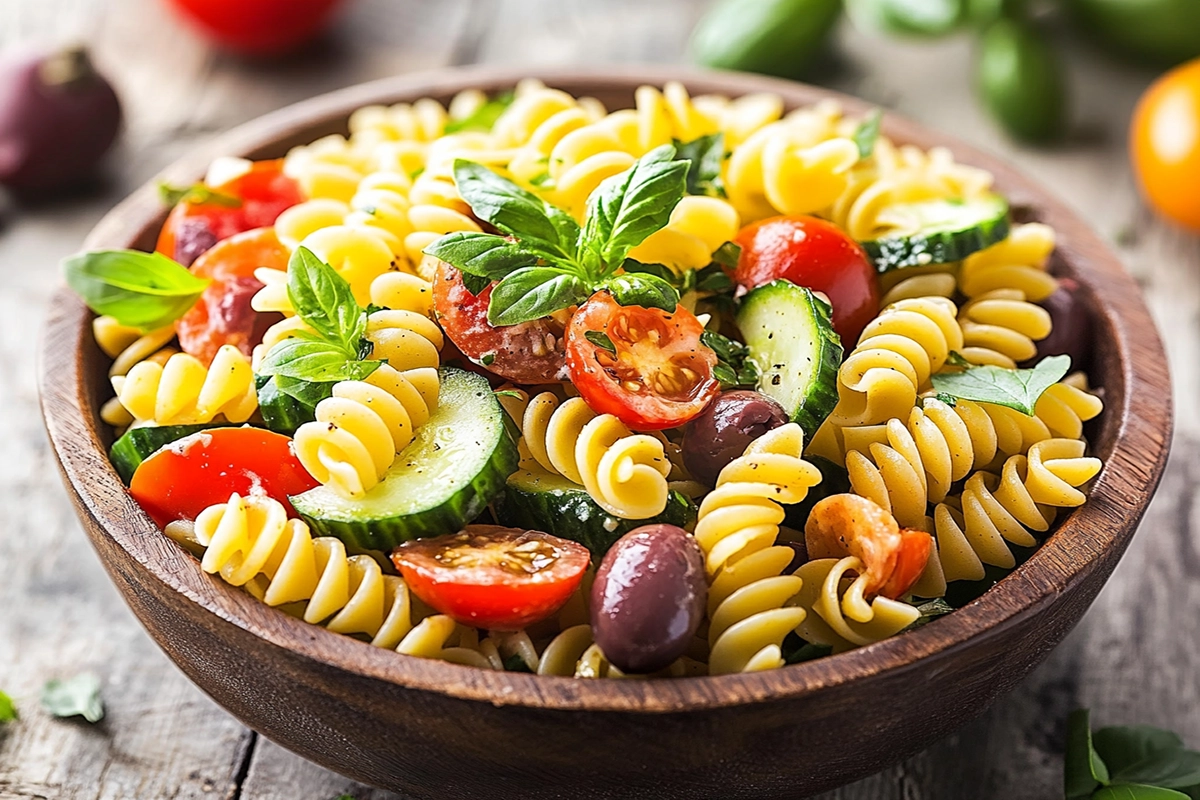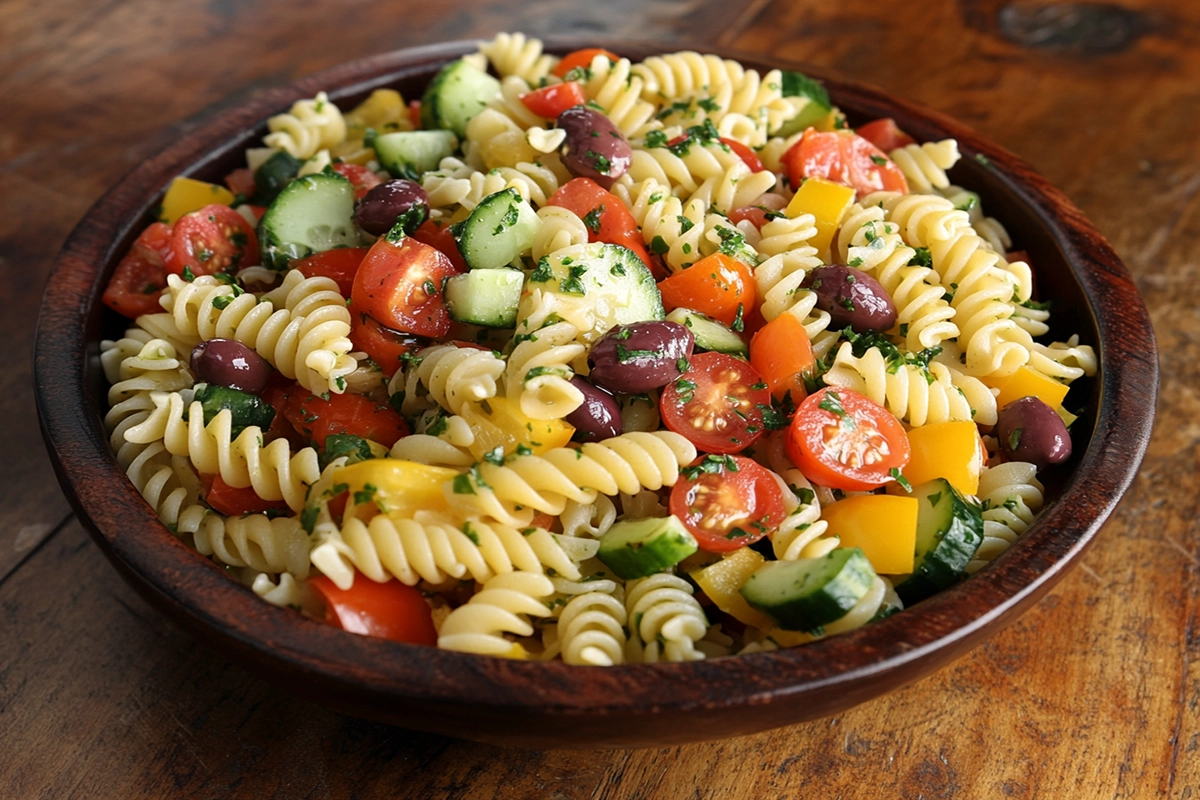Pasta salad is a go-to dish for potlucks, barbecues, and weeknight dinners because of its versatility and ease of preparation. While it may seem like a simple dish, there are some common mistakes to avoid that can affect its flavor, texture, and overall appeal. By avoiding these five mistakes to avoid in pasta salad, you can elevate your dish to a flavorful and satisfying one that everyone will enjoy. Here are the five key mistakes to avoid in pasta salad, along with tips on how to make a perfect one.
You can explore more unique pasta variations like chicken pot pie pasta or try the flavorful Philly cheesesteak tortellini pasta for a twist on traditional pasta dishes.
Table of Contents
1. Using the Wrong Pasta Shape
Choosing the right pasta shape is crucial for creating a pasta salad with the ideal texture and flavor. Not all pasta shapes work well in pasta salad, and using the wrong one is one of the five mistakes to avoid in pasta salad preparation.
Why Pasta Shape Matters
The shape and size of the pasta affect how well it holds onto the dressing and mixes with other ingredients. Long, thin pasta like spaghetti or linguine is difficult to mix evenly with other ingredients and tends to clump together. On the other hand, shorter pasta with ridges or curves, such as fusilli, rotini, or penne, can trap the dressing and mix well with the other components.
Best Pasta Shapes for Pasta Salad
- Short pasta with texture: Use pasta shapes like fusilli, farfalle, or rotini for the best results. These shapes have twists, ridges, or curves that help them catch and hold onto the dressing.
- Avoid thin noodles: Spaghetti, angel hair, or other long noodles don’t mix well in pasta salads and make it difficult to achieve an even distribution of dressing.
- Experiment with small pasta: Consider using orzo or ditalini if you want a lighter pasta salad. These small shapes offer a delicate texture and blend well with various ingredients.
Using the right pasta shape ensures that each bite is balanced, with the dressing and ingredients evenly distributed throughout the dish.
2. Overcooking or Undercooking the Pasta
Cooking the pasta to the proper doneness is one of the most important factors in making a good pasta salad. Five mistakes to avoid often include not getting the pasta just right, whether it’s overcooked or undercooked.
The Importance of Al Dente Pasta
When preparing pasta for a pasta salad, cooking it al dente—which means “to the tooth”—is essential. This ensures the pasta is firm enough to hold its shape and doesn’t become mushy when mixed with the dressing. Al dente pasta also absorbs the dressing better, making each bite flavorful.
Tips for Perfectly Cooked Pasta
- Follow the cooking instructions on the package, but check for doneness a minute or two before the recommended cooking time.
- Test the pasta for doneness: It should be tender but still have a slight firmness when bitten.
- Rinse the pasta with cold water after draining: This stops the cooking process and helps remove excess starch, which can make the pasta sticky.
Getting the texture of the pasta right is critical for making a pasta salad that feels fresh and has a pleasant bite.

3. Not Seasoning the Pasta Adequately
Another one of the five mistakes to avoid pasta salad preparation is failing to season the pasta properly. Without adequate seasoning, your salad may end up tasting bland, regardless of the dressing or other flavorful ingredients.
Why Salting the Pasta Water Is Essential
Salting the pasta water is the only time you can season the pasta itself. Once the pasta is cooked, it is difficult to infuse it with flavor, so taking this step seriously is key to making a tasty pasta salad.
How to Properly Season Pasta for Salad
- Add 1-2 tablespoons of salt per 4 quarts of water: This will help the pasta absorb some salt while it cooks, enhancing its flavor.
- Season the pasta with a bit of olive oil after draining: Drizzle a little olive oil over the pasta and toss it with a pinch of salt. This helps to add a layer of flavor before mixing with other ingredients.
- Avoid excessive rinsing: While rinsing the pasta is necessary to stop the cooking process, be careful not to rinse away all the salt. A light rinse is sufficient.
By seasoning the pasta well during cooking, you lay a solid foundation for a delicious pasta salad.
4. Adding Ingredients at the Wrong Time
Timing is everything when it comes to adding ingredients to pasta salad. One of the five mistakes to avoid in pasta salad is adding components at the wrong time, which can affect texture and flavor.
When to Add Ingredients for Best Results
Adding ingredients at the right time ensures that the flavors meld properly without sacrificing texture. Sturdier ingredients, such as roasted vegetables, meats, or olives, can be added while the pasta is warm to help the flavors blend. On the other hand, delicate ingredients like fresh herbs and cheeses should be added just before serving to preserve their quality.
Ingredient Timing Tips
- Add hearty ingredients while the pasta is still warm: This includes items like grilled chicken, roasted bell peppers, or sun-dried tomatoes, which can soak up the dressing and contribute more flavor.
- Add delicate ingredients later: Basil, arugula, feta, and other soft ingredients should be added just before serving. This helps maintain their color, texture, and flavor.
- Toss with dressing while the pasta is warm: Doing this allows the pasta to absorb the dressing better, making the salad tastier and more flavorful.
Properly timing the addition of ingredients ensures that each component maintains its texture and adds to the overall taste of the dish.
5. Using the Wrong Type or Amount of Dressing
The dressing is what brings all the flavors together in a pasta salad. Using the wrong type or too much dressing can overwhelm the dish and make it heavy, while using too little can result in a dry salad.
Choosing the Right Dressing
There are two main categories of dressings to consider for pasta salad: oil-based vinaigrettes and creamy dressings. The choice will depend on the type of pasta salad you’re making and the other ingredients in the dish.
- Oil-based vinaigrettes: These are light and perfect for pasta salads with lots of vegetables. A vinaigrette adds a fresh, tangy flavor without making the salad feel too heavy.
- Creamy dressings: Best for pasta salads with rich ingredients like cheese, bacon, or seafood. Creamy dressings add depth and richness to the dish but can make it heavy if used excessively.
Dressing Tips
- Start with a small amount of dressing and add more as needed: It’s easier to add more dressing than to take it away.
- Make homemade dressing if possible: Homemade dressings allow you to control the flavors better and avoid preservatives.
- Add a little more dressing before serving if needed: Pasta can absorb the dressing over time, so consider tossing it with an extra tablespoon or two just before serving.
Using the appropriate dressing and the right amount will enhance your pasta salad, making it both flavorful and well-balanced.

Common Variations That Can Ruin the Salad
While experimenting with pasta salad is encouraged, some variations can detract from its quality. Here are a few to avoid:
- Too many starch-heavy vegetables: Avoid overloading the salad with ingredients like potatoes or corn, which can make it feel heavy.
- Neglecting acidity: The best pasta salads have a balance of flavors, including a bit of acidity from ingredients like lemon juice or vinegar to brighten the dish.
- Storing improperly: Always store pasta salad in a covered container in the refrigerator to keep it fresh.
FAQs About Pasta Salad
1. What is the best type of pasta for pasta salad?
Short pasta shapes like fusilli, penne, and farfalle work well for pasta salad because they mix easily with other ingredients and hold the dressing. Their shapes allow the sauce to cling better than long pasta like spaghetti, which tends to clump.
2. How long should you cook pasta for pasta salad?
Cook the pasta until al dente, usually about 8-10 minutes, depending on the pasta type. Al dente means firm to the bite but not hard. This texture helps it hold up when mixed with the dressing and other ingredients.
3. Should pasta be rinsed after boiling for pasta salad?
Yes, rinsing with cold water stops the cooking process and removes excess starch, which can make the pasta sticky. It also cools the pasta down quickly, making it easier to mix with other ingredients.
4. Is it better to prepare pasta salad the day before?
Yes, making pasta salad a day ahead allows the flavors to meld. However, add fresh ingredients like herbs or greens just before serving to maintain texture. You may also need to add more dressing before serving if the pasta absorbs too much.
5. Can leftover pasta be used for pasta salad?
Yes, you can use leftover pasta, but you may need to add extra dressing to restore moisture. If it’s clumped together, rinse briefly with cold water to separate the pieces before mixing.
Conclusion
Pasta salad is a dish that can be simple yet sophisticated, but avoiding these five common mistakes is key to making a great one. Using the right pasta shape, cooking it to the proper doneness, seasoning adequately, timing ingredient additions, and choosing the right dressing will significantly improve the quality of your pasta salad. By following these tips, you’ll create a pasta salad that’s flavorful, well-balanced, and a guaranteed crowd-pleaser.
For more details about pasta varieties and their uses, you can explore this helpful resource on pasta from Wikipedia.
Don’t hesitate to experiment with different combinations of ingredients and techniques to find what works best for you. With these guidelines in mind, you’ll be able to make pasta salads that are delicious and enjoyable every time.

